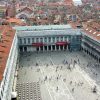The design and initial building work on the Napoleonic Wing dates from the years when Venice was part of the Kingdom of Italy (1806-1814) of which Napoleon was sovereign and his stepson, Eugene de Beauharnais, was Viceroy. The site had previously been occupied by the San Geminiano Church – an ancient foundation that had been rebuilt in the mid-16th century by Jacopo Sansovino – and ran between the Procuratie Vecchie and Nuove, the two long arcades of buildings which extend the length of St. Mark’s Square and had housed the offices and residences of some of the most important political authorities of the Venetian Republic.
Originally designed as a residence for the new sovereign, the Napoleonic Wing would only be finished in the 19th century, when Venice was under Austrian rule, serving as the official residence of the Hapsburg Court on their frequent visits to the city, and would after become the Venetian residence of the King of Italy. Complete with monumental double facade, atmospheric portico, ample staircase, and opulent Ballroom, the Napoleonic Wing was designed by the architects Giovanni Antonio Antolini, Giuseppe Soli and Lorenzo Santi. In the 1820s, the latter would be responsible for the layout of the entire Royal Palace complex, which now occupies the Procuratie Nuove as far as the Biblioteca Marciana, part of the building that had once housed the Venetian Mint, and the grounds of what became known as the Giardinetto Reale.
The Venetian painter Giuseppe Borsato worked on the interiors decoration, producing a personal and very careful interpretation of the Empire style, clearly influenced by the French architects Percier and Fontaine and the Biedermeier style that then prevailed in most of the major royal courts of Europe. The frescoed ceiling of the Main Staircase – showing The Glory of Neptune – was painted by Sebastiano Santi in 1837-38. The building has maintained many of the distinctive features of the Napoleonic and Hapsburg periods; neo-classical influence in architecture, decor, frescoes and furnishings make it an important record of the culture and style of a period. Here, the refinements of French taste go together with an interest in the traditions of Italian Art – an interest that had been reawakened by the archaeological discoveries made in the second half of the 18th century (above all, at Pompeii). The result is an ideal context for the display of this collection of works by Canova.
However, the most important aspect of the Napoleonic Wing, which seems to set itself in deliberate contraposition to the old Doge’s Palace, is that this residence of kings and emperors was the expression of a desire to open up a new chapter in the history of Venice.





